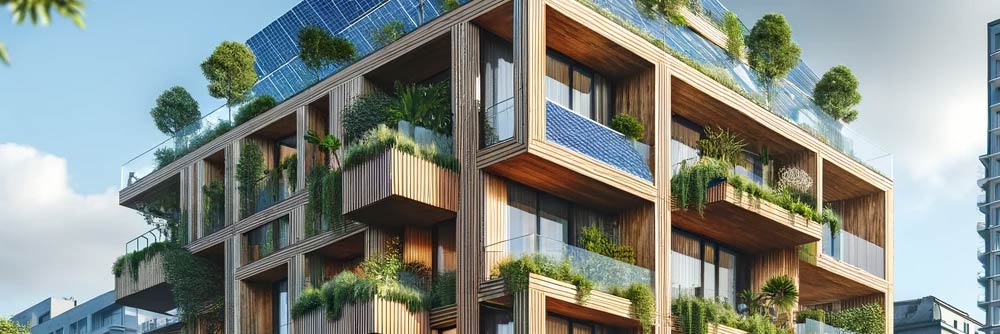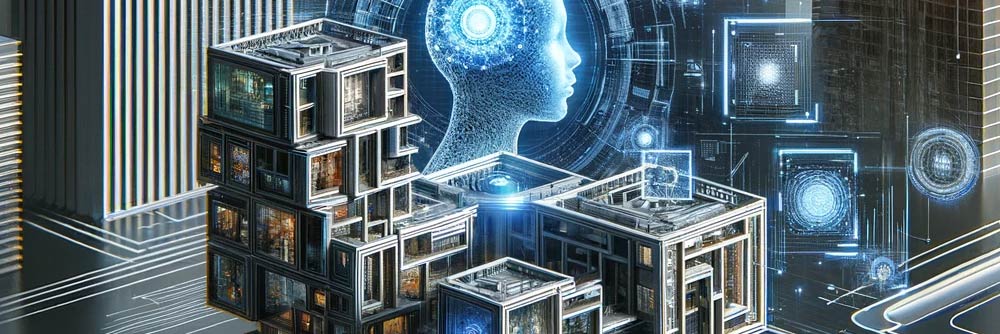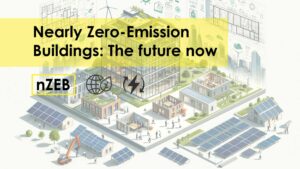As we step into 2024, the construction industry continues to evolve at an unprecedented pace. Amidst this transformation, four key trends are emerging: carbon-neutral construction, optimization due to rising material costs, increased digitization, and the integration of artificial intelligence (AI) in building design. These trends not only reflect the industry’s response to global challenges but also highlight its commitment to innovation and sustainability.
Carbon-Neutral Construction: A Sustainable Future

In 2024, the construction industry’s commitment to carbon-neutral construction is more than a trend; it’s a necessity. Carbon-neutral construction refers to building practices that aim to achieve a net-zero carbon footprint. This means that the amount of carbon emissions produced during the construction process is balanced by an equivalent amount of carbon savings elsewhere, typically through sustainable practices. These practices include using renewable energy sources, implementing energy-efficient designs, and utilizing sustainable, recycled, or upcycled materials. The goal is to minimize the environmental impact of construction activities, contributing to the broader fight against climate change.
A recent and notable example of carbon-neutral construction is the completion of the “Atlassian Sydney Headquarters” in 2023. This skyscraper in Sydney, Australia, has been designed to operate on 100% renewable energy, with innovative features like solar panels and wind turbines integrated into its design. The building is constructed using mass timber, a sustainable alternative to traditional concrete and steel, significantly reducing its carbon footprint. It’s also equipped with state-of-the-art energy-efficient systems and is designed to encourage natural ventilation and lighting, reducing the need for artificial energy consumption.
This project stands as a testament to the evolving capabilities and commitments of the construction industry towards achieving carbon neutrality. It showcases how modern technology, innovative materials, and a sustainable approach can come together to create buildings that are both environmentally responsible and functionally superior.
Optimization in the Face of Rising Material Costs

The construction industry in 2024 will be grappling with increased material costs, a situation influenced by a complex interplay of geopolitical events and a shortage of high-skilled labor. Geopolitical factors, including international trade tensions and economic policies, have led to fluctuations in the availability and pricing of essential materials like steel, lumber, and concrete. These global dynamics, coupled with the impacts of ongoing climate change and environmental policies, have put additional pressure on resource availability and costs.
Furthermore, the construction sector is experiencing a notable scarcity of high-skilled labor. This shortage is due to a combination of an aging workforce, fewer young people entering the trade, and the increasing need for specialized skills, particularly in areas like sustainable construction and digital technologies. The scarcity of skilled labor has contributed to rising labor costs, which, in turn, affects overall project costs.
In response to these challenges, the construction industry is adopting innovative approaches to maintain efficiency and manage costs. For instance, Turner Construction Company’s implementation of advanced prefabrication techniques is a direct response to these market pressures. By assembling parts of buildings in a controlled factory setting, they can reduce waste, minimize the need for high-skilled labor on-site, and ultimately cut down costs. This method has shown to reduce material wastage by a significant margin and expedite the construction process, addressing both the material cost and labor challenges.
According to a McKinsey & Company report, such innovations are not just stopgap measures but are shaping the future of construction. These methods improve efficiency, reduce environmental impact, and make construction projects more resilient against fluctuating market conditions.
The Continuous Rise of Digitization: BIM, IFC, and Digital Twins

In 2024, a significant advancement in the field of digitalization in construction will be taking place. One is the latest version of the Industry Foundation Classes (IFC) – IFC4.3. This version marks a pivotal evolution in the IFC standard, incorporating extensive updates that enhance its capabilities in infrastructure and civil engineering projects. IFC4.3 has been submitted for approval as an International Standard (ISO), a move that signifies its growing importance and acceptance in the global construction industry.
This development is crucial as it extends the applicability of IFC beyond buildings to encompass a broader range of construction projects, including roads, bridges, tunnels, and other civil works. The ISO submission of IFC4.3 underscores the industry’s commitment to fostering interoperability and standardization in construction processes, facilitating seamless collaboration and data exchange across various software platforms and disciplines.
Alongside these developments, the openBIM initiative has gained considerable momentum, particularly with contributions like IFC.js from That Open Company. openBIM is a collaborative approach that promotes open standards and workflows in Building Information Modeling, ensuring transparency, longevity, and accessibility of data across different software applications.
IFC.js, developed by That Open Company, is a groundbreaking tool that enables web-based, open-source visualization and interaction with IFC models. This innovation allows for more accessible and flexible use of BIM data, enabling professionals to view, edit, and share BIM models directly through web browsers. It represents a significant step in democratizing access to BIM technologies, making it easier for various stakeholders, regardless of their software preferences, to engage in collaborative construction projects.
In addition to these advancements, the concept of Digital Twins continues to evolve, offering increasingly sophisticated virtual replicas of physical buildings. These digital models, enriched with real-time data and analytics, are proving invaluable in optimizing building performance, facilitating predictive maintenance, and enhancing the overall design and construction process.
AI Empowering Building Design

Artificial Intelligence is playing an increasingly pivotal role in building design in 2024. AI algorithms are not just tools for efficiency; they are becoming core drivers of innovation in design. For instance, Autodesk’s generative design software exemplifies this trend. By inputting design goals and parameters, architects and engineers can use AI to explore thousands of design alternatives. These algorithms optimize for various factors, including space utilization, material usage, and energy efficiency. This approach allows for the creation of designs that offer greater optimization or effectiveness.
Sustainability is another area where AI is making a significant impact. AI-powered tools are increasingly used to analyze and predict a building’s energy consumption patterns. For example, AI-driven HVAC systems, as researched by institutions like Stanford University, can dynamically adjust to optimize energy use, leading to reductions in energy consumption by up to 20%. These smart systems learn from real-time data, adapt to changing environmental conditions, and make adjustments to maintain optimal performance and comfort.
AI algorithms are being used to process and analyze the vast amount of data generated in BIM, enabling more informed decision-making throughout the construction process. From detecting potential design conflicts to predicting project timelines and costs, AI enhances the capabilities of BIM, transforming it into a more powerful tool for builders and developers.
By analyzing data from various sources, including sensors on construction sites, AI can predict potential safety hazards and operational inefficiencies. This predictive capability allows for proactive measures, reducing the likelihood of accidents and ensuring smoother project execution.

Last month we launched our AI assistant, The BIM GYM Coach. The BIM GYM Coach is an advanced GPT (Generative Pre-trained Transformer) model, tailored specifically for BIM learning and professional development. It’s like having a personal BIM buddy 24/7. This is our third iteration of the model, which can give guidance in Autodesk Revit, Dynamo, GDL, and The ISO 19650 series.
Overall…
The construction industry in 2024 is navigating through a transformative phase, focusing on sustainability, efficiency, and technological integration. The shift towards carbon-neutral construction practices, adoption of cost-optimization methods in response to rising material prices, embracing digital tools like BIM, IFC, and Digital Twins, and the integration of AI in building design, signifies a future that is not only technologically forward but also environmentally and economically sustainable.
How do you see these trends impacting your daily work? Do you have any other trends in mind that merit our attention? Let us know in the comments!











